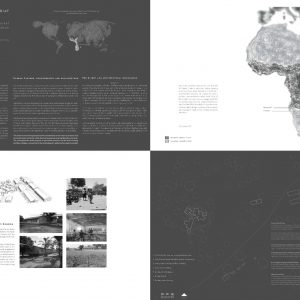“I’m blown away by how much I have learned and changed from studying architecture at this school. I feel like I have both finally come home whilst at the same time about to step into the biggest adventure of my life so far.”
Please tell us a bit about your work and your influences
Craftsmanship in material use became my design compass and I began to explore how traditional, heritage or vernacular architectural practices can provide answers to problems of sustainability. Essentially I became interested in exploring how we can use skilled labour to build with simple materials rather than the modernist approach of using unskilled labour to build with complex materials. I believe now that we need to move away from the primacy of material in architecture at the expense of quality labouring class careers to a place where aspirational labour and the crafting of materials drive the design and construction process. This shift would allow cheap, readily available, sustainably harvested materials to be used in construction to produce wonderful architecture. And for me this meant that I spent as much of my time as possible exploring materials and model making in the brilliant workshop space being helped along by those amazing, AMAZING technicians. My degree would have been a much reduced experience if it hadn’t been for the help and support from Claire, Peter, Ted, Simon and Chris.
How did you choose your course – why did you choose to study Architecture?
I wasn’t a great student my first time round the education system so studying architecture was never an option for me (even though it was kind of my secret dream). I ended up in the movie business for 20 years and then one day I just took a chance and e-mailed the school of architecture at University of Brighton asking for the opportunity to chat to someone about my life long ambition to study architecture. Luis Diaz invited me in for a walk and talk during a school break when the students were away and when he had a time to show me around. I’ll never forgot the sense of excitement and longing to belong that I felt on that first walk around the studios, seeing the models, drawings and detritus of a creative school community. And I look back on who I was then and who I am now, a few weeks away from my half century, with a life time of adventure and travel under my belt already, and I’m blown away by how much I have learned and changed from studying architecture at this school. I feel like I have both finally come home whilst at the same time about to step into the biggest adventure of my life so far.
How have you found your course and time at Brighton?
What stuck me the most about the course and how it affected me personally is that one by one my architectural heroes became first just people and then, extraordinarily, I began to loath almost every single one of them. It’s not that the school was trying to cut down the luminaries and giants in anyway, it’s that we were given the ability to understand design from whatever perspective we wanted to bring to the table. It’s like this architecture course was a place for me to bring together the threads of my life’s ramblings and to look at all those random and disparate thoughts and weave them into a story that finally made sense. And what emerged for me was a deep and invested unraveling of what modernism really was as a political and social movement and how closely linked that architectural style is to the unfolding environmental and social emergency we are now in the midst of.
I think some of this comes from the school’s focus on sustainability as a core design criteria; that once you really start to think about design and construction through that lens it becomes almost impossible not to reevaluate so much of what has come before and too look at the current norms of design as nothing less than dreadful. I have spoken with graduates of other supposedly better schools where sustainability was hardly touched on and I listen to them with a sense of… almost pity. The design skills that will be needed for a successful career given what is coming down the pipes at us involve a whole new way of thinking and I think that this school of architecture is one of those at the front of the pack of this new paradigm. And whilst the school is not perfect in other ways the architecture faculty have really tried to look at the academic and historical curriculum in a way that questions the prevailing pale, male and stale legacy of western architectural orthodoxy whilst at the same time I believe I have been equipped with the tools I’ll need to step into the real world of an architectural practice.
What are your plans after graduation?
As for the future… I have a feeling I’m going to return to Africa and spend some time looking at a way to combine agroforestry, sustainability and architecture, to think about setting up a diminutive version of my final year design project. The designs that I came up with may be rather whimsical but underneath the bonnet was a lot of very relevant thinking. I have a feeling I could take quite a bit of that research and tweak it into a live project of some sort. Onwards and upwards!




